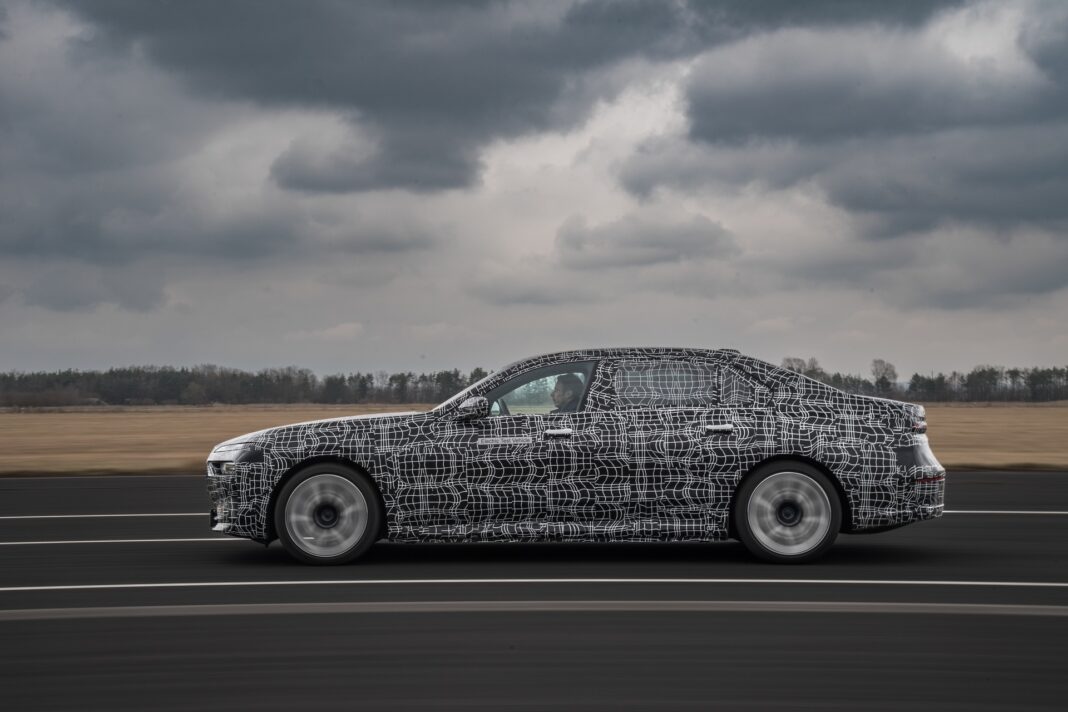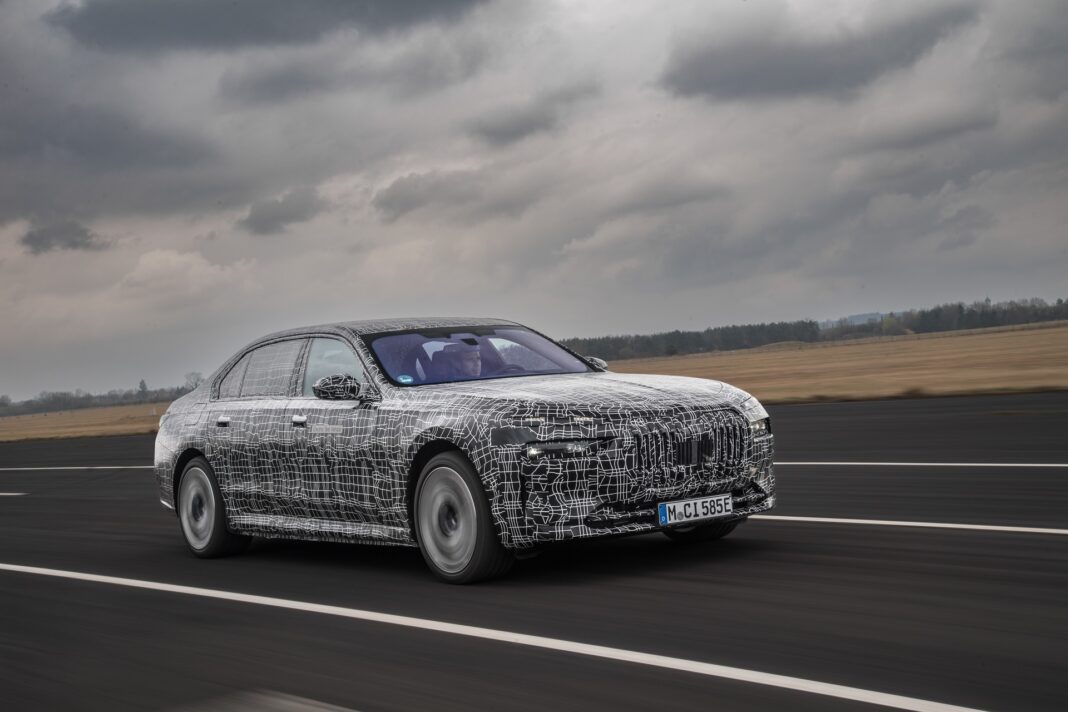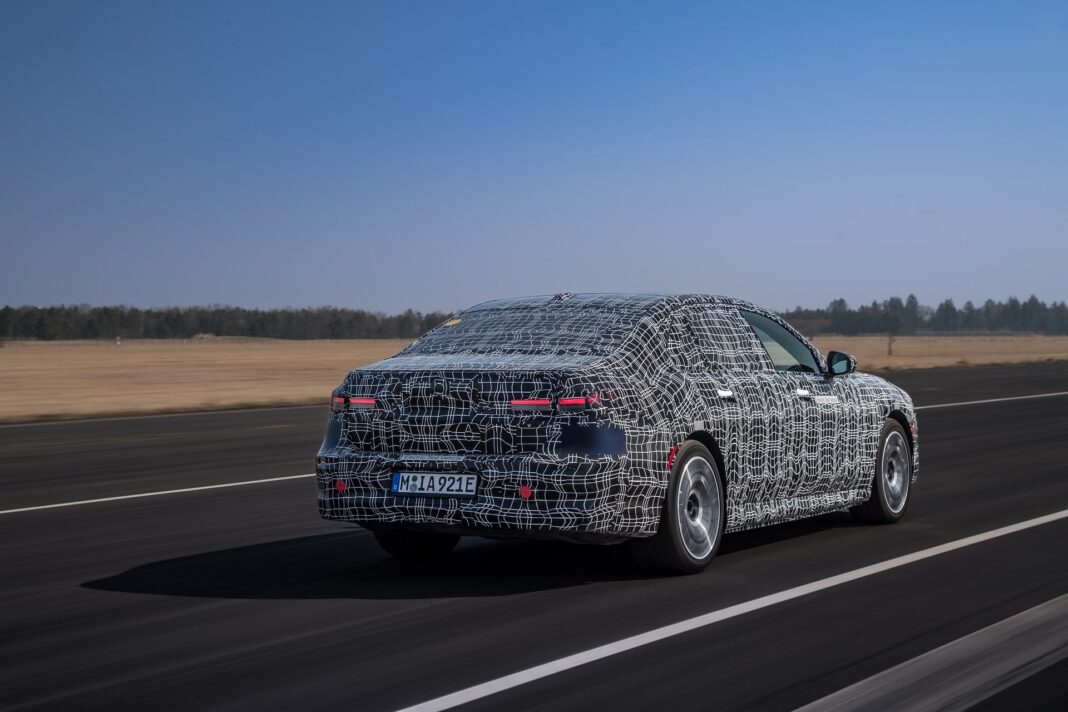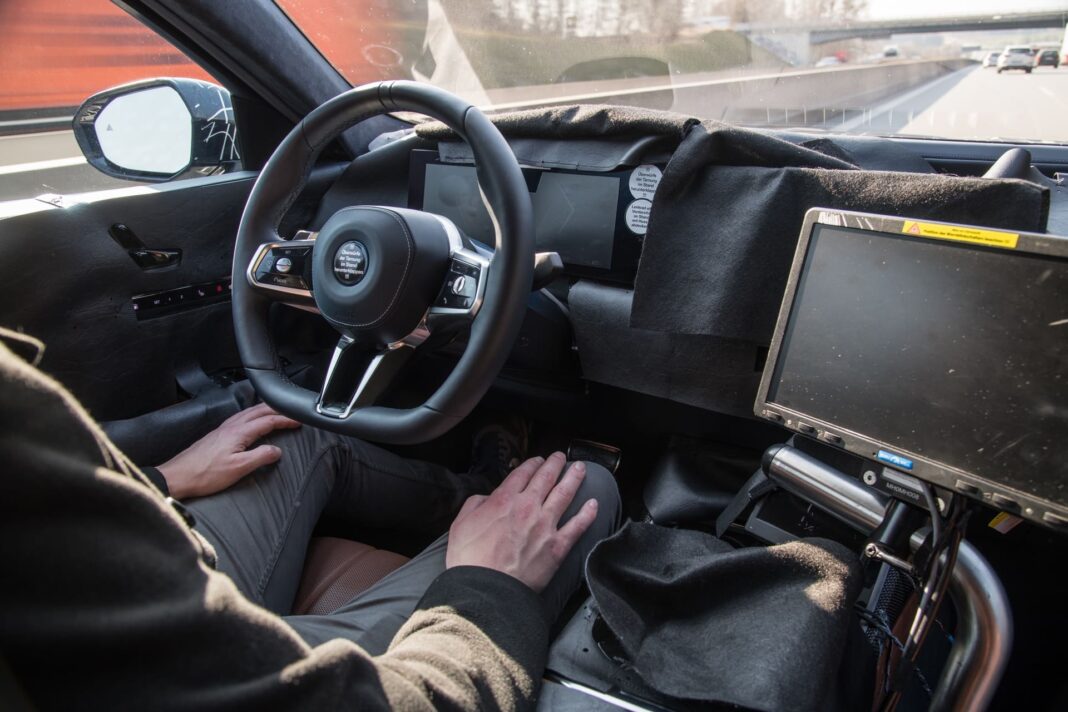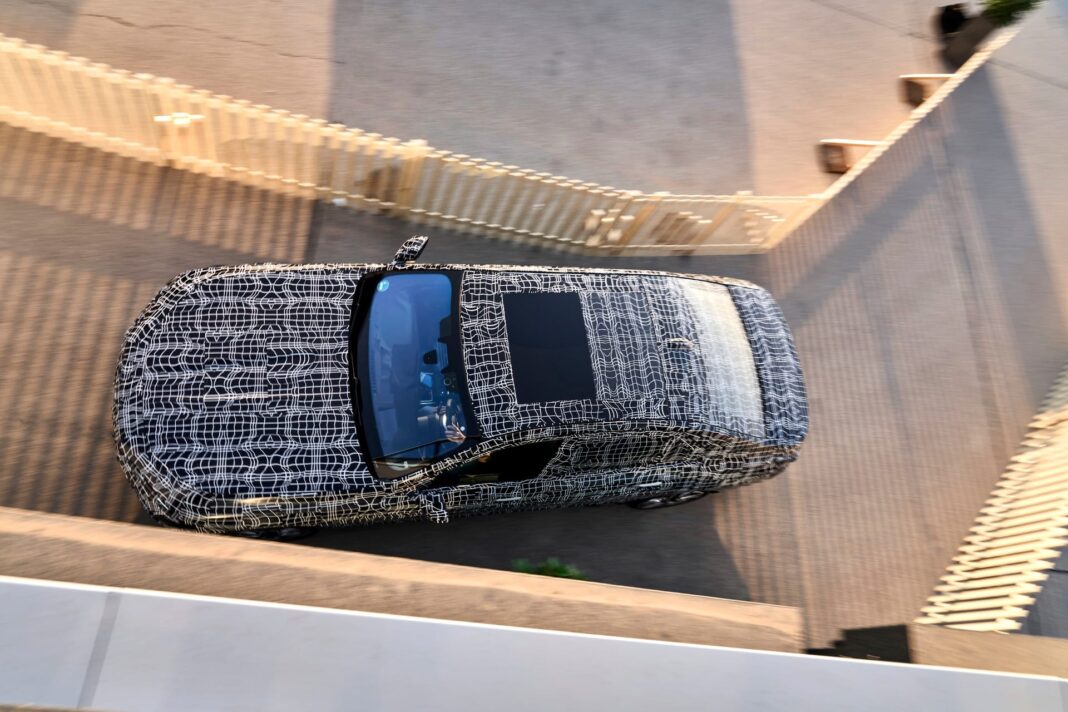BMW’s electric car offensive continues in 2022 with a new chapter. The new generation BMW 7 Series (G70) will bring forward the brand’s first ever 7 Series electric. Borrowing the naming nomenclature from the i4, the new electric limousine will be sold under the BMW i7 moniker. The production launch is scheduled for June of this year (market launch November), so ahead of the product roll-out, BMW has invited me to Munich to sample a pre-production prototype of the i7.
This is a common practice in the automotive industry, for a couple of reasons. Firstly, an early prototype drive by the media gives the engineers the opportunity to collect some feedback outside their normal testing cycle. Secondly, the marketing and press departments get to further tease their products before the official market launch. In this case, the official unveil is scheduled for April 20th, and that’s when we will get to see the new 7 Series and i7 in all its glory.
Driving A Camouflaged Prototype
As was the case with the BMW i4 prototype, the test vehicles are always covered with a camouflage tape. The BMW i7 and 7 Series gasoline-powered prototypes were no exception. The morning kicks off in Maisach where BMW also hosts a series of driving schools. The schedule has me driving the petrol-powered 7 Series back-to-back with the i7. And that’s certainly interesting because the two prototypes can’t be any different. The conventional 7 Series uses the new S68 V8 4.4 liter engine with a 48-Volt mild hybrid, while the i7 is a fully-electric drivetrain sharing some components with the BMW iX.
I will talk about the S68 and new 7 Series in a separate drive review, so in this article, the i7 takes the centerstage.
Typical amenities for a luxury limousine
From a tech perspective, BMW hasn’t shared many things with us in the briefing. I was only told that this is a pure electric 7 Series with your typical limousine amenities: integral steering, four-wheel steering, electronically-adjustable dampers and air suspension. There was no word on the battery capacity, range, horsepower output, or any other juicy tech tidbits. But luckily I covered the BMW i7 quite a bit in the past so I was able to draw some educated guesses.
For starters, the BMW i7 prototype felt like a car delivering at least 500 horsepower. As a matter of fact, it felt even more powerful than the BMW iX xDrive50 which comes with 516 horsepower. So I would say that the power range is somewhere between that and 550 ponies. Furthermore, based on pushing the i7 prototype through some tight corners, I’m certain that the xDrive system was part of the package.
So if I put this data together, it’s almost likely that this is an early prototype of the BMW i7 xDrive60 which was recently leaked by BMW of North America. But regardless of its name, the purpose of this test drive was to experience the driving dynamics of the new electric limousine. So the route has me going over a short stretch of unlimited Autobahn speeds before jumping onto the picturesque curvy roads around Munich.
One Word: FAST!
My first impressions? The BMW i7 is bonkers fast. Despite being a quite large and heavy car, the i7 is effortless to drive, and extremely quick off the line. A soft tap on the drive pedal is enough to put you back in the seat before reaching borderline legal speeds. There was no scientific test performed, but I’m confident that a 0 to 62 mph (0 to 100 km/h) will certainly come in the low 4 seconds.
And just like with the i4 and iX, the torque delivery is instant and fun. Cruising through tight bends reminds me why electric cars can be and will be fun to drive. Not only you can push the car to higher limits, thanks to the quicker power delivery, but you can also effortlessly overtake any slow traffic. There is an eBoost function as well – just like the other electric BMWs – but of course BMW held back those details. Yet, it doesn’t take a rocket scientist to feel the extra power and torque delivered in short bursts.
The two-axle air suspension behaves just like in the previous generation, but of course, it has been dialed in for the electric drivetrain and the size of the new 7 Series. It also works together with electronically controlled shocks and adjustable suspension height settings. The suspension automatically adjusts the body height with a lower ride in the Sport Mode. Of course, damping is continuously adjusted, enabling the new i7 to stabilize and smoothen out all irregularities in the road surface.
A new steering gear with standard variable ratio steering rack is also part of the BMW i7 package and that works hand-in-hand with the Integral Active Steering. The latter comes with acoustic decoupling and HSR rear axle slip angle control. Thanks to the four-wheel steering, the rear wheels can turn opposite to the front wheels to increase agility in corners. Of course, it also decreases the turning radius when parking. At high speeds, the rear wheels also turn with the front wheels to increase stability. BMW says that the rear-wheel angle can rise to 3.5 degrees.
The BMW i7 electric also features a near-actuator wheel slip allowing fully variable power transmission between the front and rear wheels. And just like with all rear-wheel drive-based BMWs, the i7 has a RWD bias in normal driving scenarios. Of course, pushing the cars into corners will deliver additional traction at the front-wheels. The overall package certainly feels similar to what I experienced in the BMW iX, but naturally, it has been adapted to the 7 Series platform.
The BMW i7 feels nimble on its toes and it would often make me forget about its heavy weight. The integrated braking system was paired in this prototype with 18 and 19 inch M Sport Brakes which proved quite useful in a couple of close calls.
Lighter Nose, Softer Steering
The steering feedback varies from the V8-powered 7 Series. The lack of a heavy front engine gives the i7 a lighter nose and in turn, a softer steering and decreased feedback from the road. I was also told that there is a slight variation in the balance of the cars as well, but no specifics were given at this time. In my experience, the BMW i7’s steering has a lot more dead zones than in the “regular” 7 Series and certainly feels lighter. Switching to Sport Mode will, of course, fix parts of that behavior.
Speaking of driving modes, the BMW i7 prototype had two modes enabled for me: Personal and Sport. The former delivers balanced settings across the entire tech stack,` and a softer ride, while the latter amps up the sportiness of the electric limousine. And just like most recent BMWs, the gap between the driving modes is significant. That’s by design though, as BMW wants to offer dual-character cars.
I would recommend the Sport Mode if you ride solo in the car, but certainly ride with the balanced setup if you have passengers with you. You also need to be careful with acceleration and braking in an electric car because you can experience motion sickness on an extended car rides. But of course, you can adjust the deceleration via the regenerative braking as well. BMW hasn’t really touched on the subject of brake-regen in the i7, but I’m convinced my prototype was set up in the Adaptive mode. And just like in the iX, the regenerative braking can change with data from the navigation system and by the sensors of the driver assistance systems.
The Most Advanced Driver Assistance Features
That brings me to the next point. The new BMW 7 Series, and implicitly the i7, comes with an extensive system of sensors and radars. A camera for object recognition is embedded in the top section of the windshield, along with a front-view camera placed in the bumper. There are two side mirror cameras and a rear-view one. Two near-range radars sit at the front of the car, along with a long-range radar. Another couple short range radars are placed at the rear of the 7 Series. Furthermore, BMW has included 12 ultrasonic sensors, split across the front and rear of the car.
Level 2 Plus Features
All this new tech works together in delivering the most advanced driver assistance system in any BMW. The new 7 Series and i7 comes with an Assisted View feature which provides augmented reality extension in the instrument cluster. There is also a new Highway Assistant (available only in the U.S. and Canada), along with a Highway Exit Assistant. The latter allows the car to change up to six lanes by itself before existing a highway. The feature will let you know as you approach your exit and by tapping the turn signal, you can confirm the exit.
The former is quite interesting too. By simply taping the turn signal in the desired direction, the new 7 Series will change the lanes. If the car detects is safe to do so. The car will also adjust its speed to safely perform the procedure. Of course, a throttle push will temporarily disable it. The Highway Assistant works at speeds up to 85 mph (137 km/h). Also, for the first time, the driver can enjoy the hands-free driving experience for prolonged times since a push on the drive or brake pedal won’t immediately disable the Level 2 Plus features. But it rather revers to Level 2 functions.
German customers also get the Urban Cruise Control with traffic light recognition. The usual Active Lane Guiding, Emergency Assistant, Collision Warning and Intelligent Speed Assistant are also included. BMW labels these new driver assistance systems as Level 2+, but the new 7 Series and i7 feature the sensor setup for a Level 3 implementation.
The parking systems have been enhanced in the new BMW 7 Series. There is now a Remote Maneuver Assistant, Parking Assistant Professional and Reversing Assistant Professional. The latter can record the path up to 100 meters.
Rolling Noise Kept In Check
Despite rolling on 20 inch wheels with winter tires, the BMW i7 was incredibly silent on the road. There was nearly no outside noise trickling in and the tire noise was kept on the outside as well. As an alternative to the 20-inch light-alloy wheels, there is a choice of 21-inch Air Performance Wheels. These deliver lower air drag and can be fitted with noise-reduced tire, which have a layer of foam on their inner surface.
The last section of my test route takes me onto the German autobahn where I had the chance to push the car to its top limit. 225 km/h comes really quick in the BMW i7, but of course, at the expense of the electric range. No word yet on the top speed.
Interior Design Similar To The iX
Naturally, some of you might be wondering about the interior design of the BMW i7, but the cabin was well camouflaged and not specc’ed with production-ready materials. Yet, there are a few things worth reporting on. Just like we mentioned in previous articles, the BMW 7 Series, and implicitly the i7, will get the two large and connected curved displays from the iX. The new 7 Series also seems to drop the physical buttons for adjusting the cabin temperature. The center console mimics the one in the iX with a minimalistic iDrive controller and gear shifter. The option of closing the doors with a touch of a button was also present, along with a new steering design featuring a flat bottom.
Unfortunately we couldn’t see the new 31-inch theater screen but we will have a chance to play with that before the official unveil.
Conclusion
Overall, the BMW i7 replicates the iX formula for luxury limousines. In many ways, the two cars are similar, but of course, the driving dynamics slightly vary. In the end, the BMW i7 is the answer to a market looking for a high-end luxurious and electric sedan, therefore it will come with features catering to that customer base. This BMW i7 prototype already feels like a well-refined product with good driving dynamics, and hopefully, decent electric range. Because despite all the luxury amenities and high-tech features, an electric limousine has to deliver a compelling driving range along with fast charging times. And implicitly, a great network infrastructure. But more on that later as we get behind the wheel of the BMW i7 production series.

